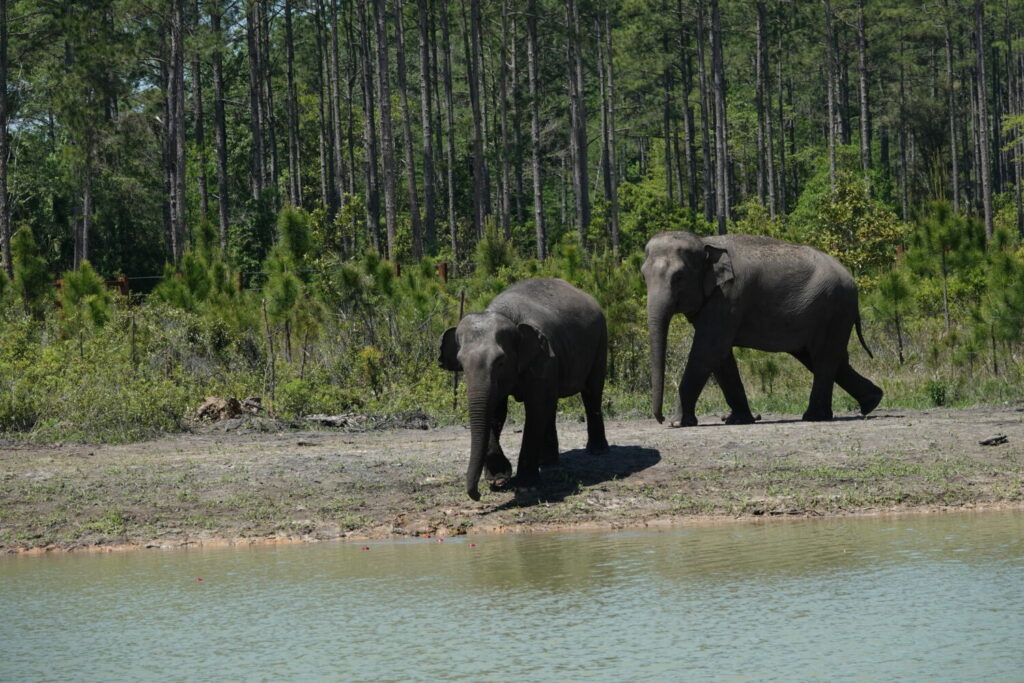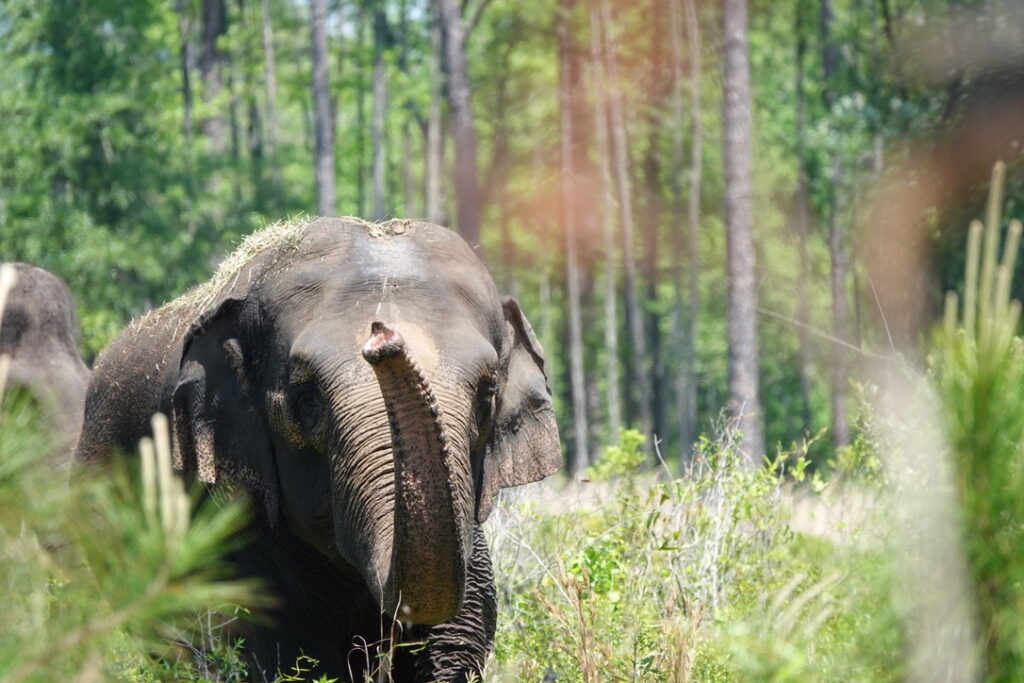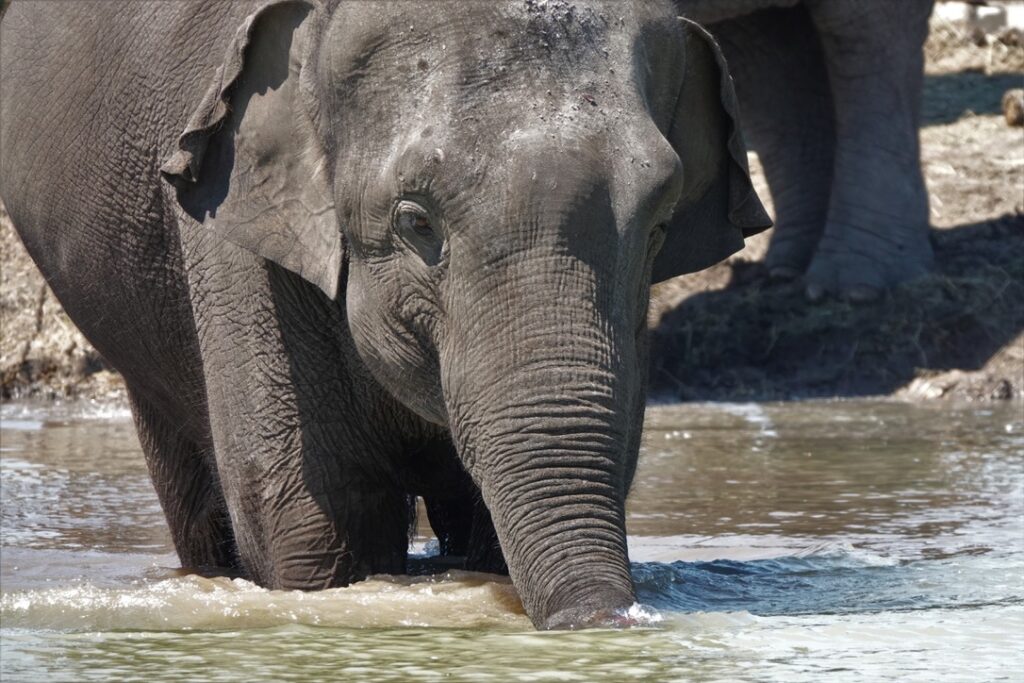Elephants Have Arrived at White Oak
The First Herd of Asian Elephants Now Call White Oak Home
The first herd of Asian elephants has arrived safely in their new forest habitat at White Oak Conservation. These 12 female elephants, ranging from 8 to 38 years old, will be joined by up to 20 more retired performing elephants as soon as additional areas are completed.
To get to White Oak, the elephants were moved 200 miles in pairs in customized trucks. Throughout the journey, the elephants were accompanied by their veterinarians and animal care specialists.
Upon arrival, they were released into two large paddocks to acclimate, adjacent to a specially designed, climate-controlled barn where veterinarians and specialists monitored their health and well-being. The elephants have now ventured out of the paddocks into pine forests with ponds, wetlands, and open grasslands.
The area the elephants now inhabit is large enough that the elephants have various habitats and food species available. They can choose to stay near the barn and their human caregivers, or wander in the woods, wallow in the mud, and swim in the pond.
White Oak Conservation’s philosophy is to accommodate animals’ natural behavior and social bonds as closely as possible so family groups will be together.
This elephant group has been socialized together for the past several months and includes two sets of full sisters and numerous half-sisters.
Asian elephants are endangered, so our work in creating environments in which animals thrive contributes to the survival of the species. Only 30,000 to 50,000 Asian elephants remain in the wild in less than 15% of their historic range. Where they do survive, they continue to be threatened by habitat degradation and fragmentation, conflict with humans, and poaching.
Our education and outreach teams are exploring how best to allow guests and students the opportunity to observe and learn from these elephants. Walter Conservation is committed to bringing elephant education and awareness to the next generation of conservationists through its world-class education and training programs, in-person and remotely. In 2019, more than 1,600 students visited White Oak and participated in education programming.
Learn how the elephants are doing in our 2022 Elephant Update
“It’s exciting to see these elephants transition into their home while continuing their strong history as ambassadors for their wild cousins. White Oak’s commitment to conservation and animal care makes it the perfect forever home for this herd. “
Deborah Olson, Executive Director, International Elephant Foundation
About Asian Elephants
Asian elephants are the largest living land mammal in Asia and the second-largest in the world behind African elephants. On average, males stand 9 ft. tall at the shoulder and weigh up to 12,000 lbs. Unlike African elephants, only male Asian elephants have tusks. Besides their tusks, elephants are distinctive due to their trunks. The trunk is an elongation of the nose and upper lip combined, with the nostrils at the tip. The trunk contains as many as 60,000 muscles, and in the case of Asian elephants, there is one finger-like projection at the end of it. Elephants use their trunks for breathing, watering, feeding, touching, dusting, washing, grasping, sound production and communication, and playing.



It is estimated that between 30,000 to 50,000 Asian elephants are in the wild, down from an estimated 100,000 at the beginning of the 20th Century. They range throughout 13 different countries in South and Southeast Asia. In many countries, the population is currently stable, but there have been drastic declines in Vietnam and Sumatra.
According to the Asian Elephant Specialist Group, the major threats to Asian elephants continues to be habitat loss and fragmentation, human-elephant conflict, and poaching and illegal trade of elephants.
Loss and fragmentation of habitat is the most important factor impacting elephant populations in most range countries in Asia. The rapid change in land use across range states has resulted in shrinkage and fragmentation of habitat, and with a growing human population, elephants are being pushed into smaller areas of forest that are surrounded by humans. This has increased human-elephant conflict, resulting in the retaliatory deaths of elephants over the destruction of crops and even from elephants being hit by motorized vehicles.
Poaching was once considered a minor threat to Asian elephants, but its significance has increased in recent years. Some bull Asian elephants can grow tusks comparable to their African counterparts, making them the target for poachers who hunt them for their ivory as well as their skin and meat. Wide-scale hunting of elephants for these products has significantly reduced the number of elephants over a wide area from Myanmar, Vietnam, to Indonesia. The trade of skin is especially concerning as it impacts the population of both male and female elephants. It is used to produce beads, pendants, skin pieces, and powder, and is sold throughout Myanmar, Laos, and China.
In situ elephant conservation (occurring within the elephants’ natural habitat) has its challenges. Some of the concern includes lack of a reliable method for population estimation, lack of specific elephant conservation/management policies in most range states, and lack of viable and well-tested solutions specifically on mitigating human-elephant conflict. Transboundary cooperation between countries and limited resources make it challenging to undertake the conservation efforts necessary to protect the elephants and their habitats. However, international efforts are in place to conserve Asian elephants.
We are excited to be a part of conserving this iconic species at White Oak.
“Our family is committed to improving the lives of individual elephants and ensuring the survival of elephants in the wild.”
Mark Walter, Walter Conservation
About White Oak and Walter Conservation
White Oak, owned by Mark and Kimbra Walter, is part of Walter Conservation. With 17,000 acres in northeastern Florida, it has long been dedicated to the conservation and care of endangered and threatened species, including rhinoceroses, okapis, bongos, zebras, condors, dama gazelles, and cheetahs.
White Oak partners with wildlife agencies here and abroad. In the United States, White Oak collaborates with federal and state agencies on species recovery and release efforts for Florida panthers, Florida grasshopper sparrows, Mississippi sandhill cranes, and whooping cranes. Eighteen of the 30 species on its grounds are endangered.
Through Walter Conservation, the Walter family conserves rare species and wild places around the world. Efforts include improving the quality of life of individual animals, recovering rare species, restoring ecosystems, and protecting wilderness areas.
Thus far, their philanthropy protects important areas in North America and Africa. The Walter Conservation approach is to provide wildlife security and management, to collaborate with local residents and host-country governments, and to invest in sustainable enterprises.
